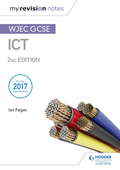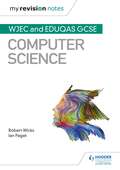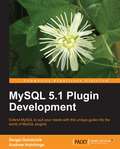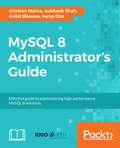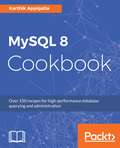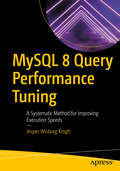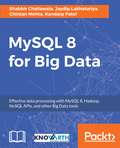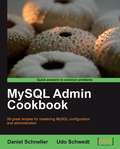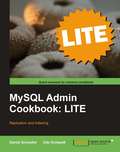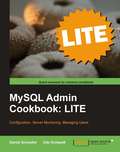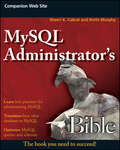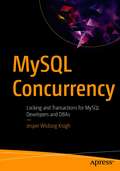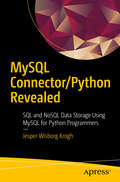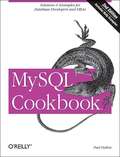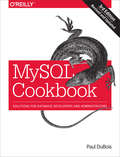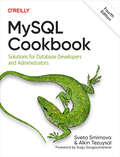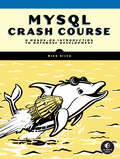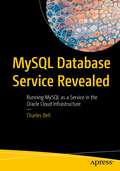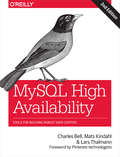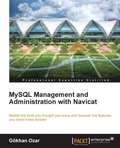- Table View
- List View
My Revision Notes: WJEC ICT for GCSE 2nd Edition (My Revision Notes)
by Ian PagetUnlock your full potential with this revision guide, fully updated for the 2017 specification, which focuses on the key content and skills you need to know.With My Revision Notes for WJEC ICT for GCSE you can: - Take control of your revision: plan and focus on the areas you need to revise with content summaries and commentary from author Ian Paget.- Show you fully understand key topics by using specific examples of ICT.- Apply ICT terms accurately with the help of definitions and key words on all topics.- Improve your skills to tackle specific exam questions with self-testing and exam-style questions.
My Revision Notes: WJEC and Eduqas GCSE Computer Science (My Revision Notes)
by Robert Wicks Ian PagetExam board: WJECLevel: GCSESubject: Computer ScienceFirst teaching: September 2017First exams: Summer 2019Strengthen your students' understanding and upgrade their confidence with My Revision Notes: WJEC Eduqas GCSE (9-1) Computer Science.Written by leading Computer Science experts this is the only revision guide aimed specifically at helping students prepare for the WJEC or Eduqas exam - a new title in the top-selling revision guide series, loved by students and recommended by teachers.· Let students take control of their revision - plan and focus on the areas where they need to improve their knowledge and understanding with advice and summaries from the experts.· Help them achieve their potential - exam tips on computer science terms and concepts highlighted throughout the book· Improve their exam skills - a range of exam practice questions and 'test yourself questions' with answers at the back of the book.
My Revision Notes: Wjec Ict For Gcse 2nd Edition Epub
by Ian PagetUnlock your full potential with this revision guide, fully updated for the 2017 specification, which focuses on the key content and skills you need to know.With My Revision Notes for WJEC ICT for GCSE you can: - Take control of your revision: plan and focus on the areas you need to revise with content summaries and commentary from author Ian Paget.- Show you fully understand key topics by using specific examples of ICT.- Apply ICT terms accurately with the help of definitions and key words on all topics.- Improve your skills to tackle specific exam questions with self-testing and exam-style questions.
My Third Book of Computers - 3
by B. TraajThe Berry Garden curriculum includes a book called "My Book of Computers," which focuses on the fundamentals of computers, including different parts, software, and basic applications such as Word, Paint, and Logo. This book also provides engaging activities that allow children to explore and interact with computers, promoting their understanding and familiarity with technology from an early age.
My personal Adaptive Global NET (MAGNET)
by Ramjee PrasadThe innovative concept of Personal Network (PN), which was introduced and developed in MAGNET, finds in this book the first confirmation of the success that the future of wireless communications is bound to achieve. The importance of this book is not only related to being the first work on PNs, it also gives an overview of operation of a big project, like MAGNET, and in fact the organisation of the book reflects how the project itself has been structured. My personal Adaptive Global NET (MAGNET) summarize all the steps taken from the introduction of a user-centric perspective until the implementation of PN-Fs (Federation of Personal Networks), outlining the applications and commercialisations of the new concepts carried out of the project. The intent of My personal Adaptive Global NET (MAGNET) is to disseminate the concept of PN and PN-F along with the activities and achievement carried out in MAGNET/MAGNET Beyond to encourage new project and academic initiatives toward personalized, ubiquitous communications.
MySQL 5.1 Plugin Development
by Andrew HutchingsThis book is written in a hands-on style that actively involves you while you read through its chapters. In every chapter you, along with the author, will be implementing one or more fully working example plugins. The process is accompanied with a detailed step-by-step explanation of the code, at the same time providing you with resources to create your own plugins. If you are a MySQL application developer or a programmer who wants to interface with MySQL server, this book is for you. Basic knowledge of C/C++, SQL, and MySQL in particular is assumed in the book, but no deep familiarity with any of the topics is required.
MySQL 8 Administrator’s Guide: Effective guide to administering high-performance MySQL 8 solutions
by Chintan Mehta Hetal Oza Ankit K Bhavsar Subhash ShahStep by step guide to monitor, manage, and secure your database engine Key Features Your companion to master all the administration-related tasks in MySQL 8 Ensure high performance and high availability of your MySQL solution using effective replication and backup techniques A comprehensive guide to performing query optimization, security and a whole host of other administrative tasks in MySQL 8 Book Description MySQL is one of the most popular and widely used relational databases in the world today. The recently released version 8.0 brings along some major advancements in the way your MySQL solution can be administered. This handbook will be your companion to understand the newly introduced features in MySQL and how you can leverage them to design a high-performance MySQL solution for your organization. This book starts with a brief introduction to the newly introduced features in MySQL 8, followed by quickly jumping onto the crucial administration topics that you will find useful in your day to day work. Topics such as migrating to MySQL 8, MySQL benchmarking, achieving high performance by implementing the indexing techniques, and optimizing your queries are covered in this book. You will also learn how to perform replication, scale your MySQL solution and implement effective security techniques. A special section on the common and not so common troubleshooting techniques for effective MySQL administration is also covered in this book. By the end of this highly practical book, you will have all the knowledge you need to tackle any problem you might encounter while administering your MySQL solution. What you will learn Understanding different MySQL 8 data types based on type of contents and storage requirements Best practices for optimal use of features in MySQL 8 Explore globalization configuration and caching techniques to improve performance Create custom storage engine as per system requirements Learn various ways of index implementation for flash memory storages Configure and implement replication along with approaches to use replication as solution Understand how to make your MySQL 8 solution highly available Troubleshoot common issues and identify error codes while using MySQL 8 Who this book is for This book is intended for MySQL administrators who are looking for a handy guide covering all the MySQL administration-related tasks. If you are a DBA looking to get started with MySQL administration, this book will also help you. Knowledge of the basic database concepts is required to get started with this book.
MySQL 8 Cookbook: Over 150 recipes for high-performance database querying and administration
by Karthik Appigatla Kedar Mohaniraj VaijanapukarDesign and administer enterprise-grade MySQL 8 solutions Key Features Store, retrieve, and manipulate your data using the latest MySQL 8 features Practical recipes on effective administration in MySQL, with a focus on security, performance tuning, troubleshooting, and more Contains tips, tricks, and best practices for designing, developing, and administering your MySQL 8 database solution without any hassle Book Description MySQL is one of the most popular and widely used relational databases in the World today. The recently released MySQL 8 version promises to be better and more efficient than ever before. This book contains everything you need to know to be the go-to person in your organization when it comes to MySQL. Starting with a quick installation and configuration of your MySQL instance, the book quickly jumps into the querying aspects of MySQL. It shows you the newest improvements in MySQL 8 and gives you hands-on experience in managing high-transaction and real-time datasets. If you've already worked with MySQL before and are looking to migrate your application to MySQL 8, this book will also show you how to do that. The book also contains recipes on efficient MySQL administration, with tips on effective user management, data recovery, security, database monitoring, performance tuning, troubleshooting, and more. With quick solutions to common and not-so-common problems you might encounter while working with MySQL 8, the book contains practical tips and tricks to give you the edge over others in designing, developing, and administering your database effectively. What you will learn - Install and configure your MySQL 8 instance without any hassle - Get to grips with new features of MySQL 8 like CTE, Window functions and many more - Perform backup tasks, recover data and set up various replication topologies for your database - Maximize performance by using new features of MySQL 8 like descending indexes, controlling query optimizer and resource groups - Learn how to use general table space to suit the SaaS or multi-tenant applications - Analyze slow queries using performance schema, sys schema and third party tools - Manage and monitor your MySQL instance and implement efficient performance-tuning tasks Who this book is for If you are a MySQL developer or administrator looking for quick, handy solutions to solve the most common and not-so-common problems in MySQL, this book is for you. MySQL DBAs looking to get up-to-speed with the latest MySQL 8 development and administration features will also find this book very useful. Prior knowledge of Linux and RDBMS is desirable.
MySQL 8 Query Performance Tuning: A Systematic Method for Improving Execution Speeds
by Jesper Wisborg KroghIdentify, analyze, and improve poorly performing queries that damage user experience and lead to lost revenue for your business. This book will help you make query tuning an integral part of your daily routine through a multi-step process that includes monitoring of execution times, identifying candidate queries for optimization, analyzing their current performance, and improving them to deliver results faster and with less overhead. Author Jesper Krogh systematically discusses each of these steps along with the data sources and the tools used to perform them. MySQL 8 Query Performance Tuning aims to help you improve query performance using a wide range of strategies. You will know how to analyze queries using both the traditional EXPLAIN command as well as the new EXPLAIN ANALYZE tool. You also will see how to use the Visual Explain feature to provide a visually-oriented view of an execution plan. Coverage of indexes includes indexing strategies and index statistics, and you will learn how histograms can be used to provide input on skewed data distributions that the optimizer can use to improve query performance. You will learn about locks, and how to investigate locking issues. And you will come away with an understanding of how the MySQL optimizer works, including the new hash join algorithm, and how to change the optimizer’s behavior when needed to deliver faster execution times. You will gain the tools and skills needed to delight application users and to squeeze the most value from corporate computing resources. What You Will LearnMonitor query performance to identify poor performersChoose queries to optimize that will provide the greatest gainAnalyze queries using tools such as EXPLAIN ANALYZE and Visual ExplainImprove slow queries through a wide range of strategiesProperly deploy indexes and histograms to aid in creating fast execution plansUnderstand and analyze locks to resolve contention and increase throughputWho This Book Is ForDatabase administrators and SQL developers who are familiar with MySQL and need to participate in query tuning. While some experience with MySQL is required, no prior knowledge of query performance tuning is needed.
MySQL 8 for Big Data
by Chintan Mehta Shabbir Challawala Jaydip Lakhatariya Kandarp PatelUncover the power of MySQL 8 for Big Data About This Book • Combine the powers of MySQL and Hadoop to build a solid Big Data solution for your organization • Integrate MySQL with different NoSQL APIs and Big Data tools such as Apache Sqoop • A comprehensive guide with practical examples on building a high performance Big Data pipeline with MySQL Who This Book Is For This book is intended for MySQL database administrators and Big Data professionals looking to integrate MySQL 8 and Hadoop to implement a high performance Big Data solution. Some previous experience with MySQL will be helpful, although the book will highlight the newer features introduced in MySQL 8. What You Will Learn • Explore the features of MySQL 8 and how they can be leveraged to handle Big Data • Unlock the new features of MySQL 8 for managing structured and unstructured Big Data • Integrate MySQL 8 and Hadoop for efficient data processing • Perform aggregation using MySQL 8 for optimum data utilization • Explore different kinds of join and union in MySQL 8 to process Big Data efficiently • Accelerate Big Data processing with Memcached • Integrate MySQL with the NoSQL API • Implement replication to build highly available solutions for Big Data In Detail With organizations handling large amounts of data on a regular basis, MySQL has become a popular solution to handle this structured Big Data. In this book, you will see how DBAs can use MySQL 8 to handle billions of records, and load and retrieve data with performance comparable or superior to commercial DB solutions with higher costs. Many organizations today depend on MySQL for their websites and a Big Data solution for their data archiving, storage, and analysis needs. However, integrating them can be challenging. This book will show you how to implement a successful Big Data strategy with Apache Hadoop and MySQL 8. It will cover real-time use case scenario to explain integration and achieve Big Data solutions using technologies such as Apache Hadoop, Apache Sqoop, and MySQL Applier. Also, the book includes case studies on Apache Sqoop and real-time event processing. By the end of this book, you will know how to efficiently use MySQL 8 to manage data for your Big Data applications. Style and approach Step by Step guide filled with real-world practical examples.
MySQL Admin Cookbook
by Daniel Schneller Udo SchwedtThis book uses the approach of a cookbook, presenting solutions to problems in the form of recipes. Each recipe provides the reader with easy step-by-step descriptions of the actions necessary to accomplish a specific task. Example values and code samples are used throughout the recipes, which makes adaptation for individual needs easy Administrators of all skill-levels will find step-by-step instructions for practical approaches to MySQL configuration, maintenance, and optimization topics. Each recipe uses a concrete example for easy understanding. This book is for ambitious MySQL users as well as professional data center database administrators. Beginners as well as experienced administrators will profit from this cookbook and get fresh ideas to improve their MySQL environments. Detailed background information will enable them to widen their MySQL horizon. It does not cover SQL basics, how to install MySQL servers, or how to design a relational database schema. Readers are expected to have a basic understanding of the SQL language and database concepts in general.
MySQL Admin Cookbook LITE: Configuration, Server Monitoring, Managing Users
by Daniel Schneller Udo SchwedtThis cookbook presents solutions to problems in the form of recipes. Each recipe provides the reader with easy step-by-step descriptions of the actions necessary to accomplish a specific task. Example values and code samples are used throughout the recipes, which makes adaptation for individual needs easy. This book is for ambitious MySQL users as well as professional data center database administrators. Beginners as well as experienced administrators will benefit from this cookbook and get fresh ideas to improve their MySQL environments. Detailed background information will enable them to widen their MySQL horizon. It does not cover SQL basics, how to install MySQL servers, or how to design a relational database schema. Readers are expected to have a basic understanding of the SQL language and database concepts in general.
MySQL Admin Cookbook LITE: Replication and Indexing
by Daniel Schneller Udo SchwedtThis cookbook presents solutions to problems in the form of recipes. Each recipe provides the reader with easy step-by-step descriptions of the actions necessary to accomplish a specific task. Example values and code samples are used throughout the recipes, which makes adaptation for individual needs easy. This book is for ambitious MySQL users as well as professional data center database administrators. Beginners as well as experienced administrators will benefit from this cookbook and get fresh ideas to improve their MySQL environments. Detailed background information will enable them to widen their MySQL horizon. It does not cover SQL basics, how to install MySQL servers, or how to design a relational database schema. Readers are expected to have a basic understanding of the SQL language and database concepts in general.
MySQL Administrator's Bible
by Sheeri K. Cabral Keith MurphyWith special focus on the next major release of MySQL, this resource provides a solid framework for anyone new to MySQL or transitioning from another database platform, as well as experience MySQL administrators. The high-profile author duo provides essential coverage of the fundamentals of MySQL database management-including MySQL's unique approach to basic database features and functions-as well as coverage of SQL queries, data and index types, stores procedure and functions, triggers and views, and transactions. They also present comprehensive coverage of such topics as MySQL server tuning, managing storage engines, caching, backup and recovery, managing users, index tuning, database and performance monitoring, security, and more.
MySQL Concurrency: Locking and Transactions for MySQL Developers and DBAs
by Jesper Wisborg KroghKnow how locks work in MySQL and how they relate to transactions. This book explains the major role that locks play in database systems, showing how locks are essential in allowing high-concurrency workloads. You will learn about lock access levels and lock granularities from the user level as well as table locks to record and gap locks. Most importantly, the book covers troubleshooting techniques when locking becomes a pain point. Several of the lock types in MySQL have a duration of a transaction. For this reason, it is important to understand how transactions work. This book covers the basics of transactions as well as transaction isolation levels and how they affect locking. The book is meant to be your go-to resource for solving locking contention and similar problems in high-performance MySQL database applications. Detecting locking issues when they occur is the first key to resolving such issues. MySQL Concurrency provides techniques for detecting locking issues such as contention. The book shows how to analyze locks that are causing contention to see why those locks are in place. A collection of six comprehensive case studies combine locking and transactional theory with realistic lock conflicts. The case studies walk you through the symptoms to look for in order to identify which issue you are facing, the cause of the conflict, its analysis, solution, and how to prevent the issue in the future. What You Will LearnUnderstand which lock types exist in MySQL and how they are usedChoose the best transaction isolation level for a given transactionDetect and analyze lock contention when it occursReduce locking issues in your applicationsResolve deadlocks between transactionsResolve InnoDB record-level locking issuesResolve issues from metadata and schema locksWho This Book Is ForDatabase administrators and SQL developers who are familiar with MySQL and want to gain a better understanding of locking and transactions as well as how to work with them. While some experience with MySQL is required, no prior knowledge of locks and transactions is needed.
MySQL Connector/Python Revealed: SQL and NoSQL Data Storage Using MySQL for Python Programmers
by Jesper Wisborg KroghMove data back and forth between database and application. The must-have knowledge in this book helps programmers learn how to use the official driver, MySQL Connector/Python, by which Python programs communicate with the MySQL database. This book takes you from the initial installation of the connector through basic query execution, then through more advanced topics, error handing, and troubleshooting. The book covers both the traditional API as well as the new X DevAPI. The X DevAPI is part of MySQL 8.0 and is an API that can be used with connectors for several programming languages and is used from the command-line interface known as MySQL Shell. You will learn to use the connector by working through code examples and following a discussion of how the API calls work. By the end of the book, you will be able to use MySQL as the back-end storage for your Python programs, and you’ll even have the option of choosing between SQL and NoSQL interfaces. What You'll LearnInstall MySQL Connector/PythonConnect to MySQL and configure database accessExecute SQL and NoSQL queries from your Python programTrap errors and troubleshoot problemsStore data from different languages using MySQL’s character set supportWork in the X DevAPI that underlies all of MySQL’s language connectorsWho This Book Is ForDevelopers familiar with Python who are looking at using MySQL as the back-end database. No prior knowledge of Connector/Python is assumed, but readers should be familiar with databases and the Python programming language.
MySQL Cookbook
by Paul DuboisAlong with MySQL's popularity has come a flood of questions about solving specific problems, and that's where this Cookbook is essential. Designed as a handy resource when you need quick solutions or techniques, the book offers dozens of short, focused pieces of code and hundreds of worked-out examples for programmers of all levels who don't have the time (or expertise) to solve MySQL problems from scratch. The new edition covers MySQL 5.0 and its powerful new features, as well as the older but still widespread MySQL 4.1. One major emphasis of this book is how to use SQL to formulate queries for particular kinds of questions, using the mysql client program included in MySQL distributions. The other major emphasis is how to write programs that interact with the MySQL server through an API. You'll find plenty of examples using several language APIs in multiple scenarios and situations, including the use of Ruby to retrieve and format data. There are also many new examples for using Perl, PHP, Python, and Java as well. Other recipes in the book teach you to: Access data from multiple tables at the same time Use SQL to select, sort, and summarize rows Find matches or mismatches between rows in two tables Determine intervals between dates or times, including age calculations Store images into MySQL and retrieve them for display in web pages Get LOAD DATA to read your data files properly or find which values in the file are invalid Use strict mode to prevent entry of bad data into your database Copy a table or a database to another server Generate sequence numbers to use as unique row identifiers Create database events that execute according to a schedule And a lot more MySQL Cookbook doesn't attempt to develop full-fledged, complex applications. Instead, it's intended to assist you in developing applications yourself by helping you get past problems that have you stumped.
MySQL Cookbook
by Paul DuboisMySQL Cookbook provides a unique problem-and-solution format that offers practical examples for everyday programming dilemmas. For every problem addressed in the book, there's a worked-out solution or "recipe" -- short, focused pieces of code that you can insert directly into your applications. More than a collection of cut-and-paste code, this book explanation how and why the code works, so you can learn to adapt the techniques to similar situations.
MySQL Cookbook: Solutions for Database Developers and Administrators
by Sveta Smirnova Alkin TezuysalFor MySQL, the price of popularity comes with a flood of questions from users on how to solve specific data-related issues. That's where this cookbook comes in. When you need quick solutions or techniques, this handy resource provides scores of short, focused pieces of code, hundreds of worked-out examples, and clear, concise explanations for programmers who don't have the time (or expertise) to resolve MySQL problems from scratch.In this updated fourth edition, authors Sveta Smirnova and Alkin Tezuysal provide more than 200 recipes that cover powerful features in both MySQL 5.7 and 8.0. Beginners as well as professional database and web developers will dive into topics such as MySQL Shell, MySQL replication, and working with JSON.You'll learn how to:Connect to a server, issue queries, and retrieve resultsRetrieve data from the MySQL ServerStore, retrieve, and manipulate stringsWork with dates and timesSort query results and generate summariesAssess the characteristics of a datasetWrite stored functions and proceduresUse stored routines, triggers, and scheduled eventsPerform basic MySQL administration tasksUnderstand MySQL monitoring fundamentals
MySQL Cookbook: Solutions for Database Developers and Administrators
by Paul DuboisMySQL’s popularity has brought a flood of questions about how to solve specific problems, and that’s where this cookbook is essential. When you need quick solutions or techniques, this handy resource provides scores of short, focused pieces of code, hundreds of worked-out examples, and clear, concise explanations for programmers who don’t have the time (or expertise) to solve MySQL problems from scratch.Ideal for beginners and professional database and web developers, this updated third edition covers powerful features in MySQL 5.6 (and some in 5.7). The book focuses on programming APIs in Python, PHP, Java, Perl, and Ruby. With more than 200+ recipes, you’ll learn how to:Use the mysql client and write MySQL-based programsCreate, populate, and select data from tablesStore, retrieve, and manipulate stringsWork with dates and timesSort query results and generate summariesUse stored routines, triggers, and scheduled eventsImport, export, validate, and reformat dataPerform transactions and work with statisticsProcess web input, and generate web content from query resultsUse MySQL-based web session managementProvide security and server administration
MySQL Crash Course: A Hands-on Introduction to Database Development
by Rick SilvaWith databases lurking in the background of every website, knowing how to manage them with MySQL is a no-brainer. This practical, hands-on introduction teaches readers all they need to know.MySQL Crash Course is a fast-paced, no-nonsense introduction to relational database development. It&’s filled withpractical examples and expert advice that will have you up and running quickly.You&’ll learn the basics of SQL, how to create a database, craft SQL queries to extract data, and work with events,procedures, and functions. You&’ll see how to add constraints to tables to enforce rules about permitted data and useindexes to accelerate data retrieval. You&’ll even explore how to call MySQL from PHP, Python, and Java.Three final projects will show you how to build a weather database from scratch, use triggers to prevent errors in anelection database, and use views to protect sensitive data in a salary database.You&’ll also learn how to:Query database tables for specific information, order the results, comment SQL code, and deal with null valuesDefine table columns to hold strings, integers, and dates, and determine what data types to useJoin multiple database tables as well as use temporary tables, common table expressions, derived tables, andsubqueriesAdd, change, and remove data from tables, create views based on specific queries, write reusable stored routines, and automate and schedule eventsThe perfect quick-start resource for database developers, MySQL Crash Course will arm you with the tools you needto build and manage fast, powerful, and secure MySQL-based data storage systems.
MySQL Database Service Revealed: Running MySQL as a Service in the Oracle Cloud Infrastructure
by Charles BellAccess all the information you need to begin using the MySQL Database Service (MDS) in the Oracle Cloud Infrastructure (OCI). MDS is Oracle’s new platform as a service (PAAS) offering for open-source database users. This book covers getting started with an account in OCI, gives a brief overview of OCI services available, and provides a short tutorial on MDS. Reading this book helps you take advantage of the powerful OCI features by building your own MySQL database in the cloud. Examples in this book center around running MDS in OCI, and include several of the popular use cases as well as advice on how to implement them. In addition, you will learn more about the related MDS OCI features, such as the high availability features currently available. Finally, you will learn how to back up and restore your data as well as how to get your data into and out of the cloud. The skills you learn in this book will help you get started using MDS and letting Oracle do the heavy lifting of managing MDS operations and implementation.What You Will LearnUse Oracle Cloud Infrastructure (OCI)Deploy MySQL Database Service (MDS) systems in the cloudConnect your applications to MDSBack up and recover using the data recovery features of MDSEmploy the newest high availability features of MDSWho This Book Is ForSystems engineers, developers, and database professionals who want to learn about the powerful features of the MySQL Database Service (MDS) and how to incorporate cloud-based database storage into their infrastructure and applications. Readers who are new to MySQL will appreciate the tutorial chapter, and those familiar with MySQL will learn the latest features of MDS as well as how to build inexpensive, powerful MySQL database servers in the Oracle Cloud Infrastructure (OCI).
MySQL High Availability: Tools for Building Robust Data Centers
by Lars Thalmann Charles Bell Mats KindahlServer bottlenecks and failures are a fact of life in any database deployment, but they don’t have to bring everything to a halt. This practical book explains replication, cluster, and monitoring features that can help protect your MySQL system from outages, whether it’s running on hardware, virtual machines, or in the cloud.Written by engineers who designed many of the tools covered, this book reveals undocumented or hard-to-find aspects of MySQL reliability and high availability—knowledge that’s essential for any organization using this database system. This second edition describes extensive changes to MySQL tools. Versions up to 5.5 are covered, along with several 5.6 features.Learn replication fundamentals, including use of the binary log and MySQL Replicant LibraryHandle failing components through redundancyScale out to manage read-load increases, and use data sharding to handle large databases and write-load increasesStore and replicate data on individual nodes with MySQL ClusterMonitor database activity and performance, and major operating system parametersKeep track of masters and slaves, and deal with failures and restarts, corruption, and other incidentsExamine tools including MySQL Enterprise Monitor, MySQL Utilities, and GTIDs
MySQL Management and Administration with Navicat
by Gökhan OzarStandard Mini. This book is written for MySQL Users, Developers, and admins who want to discover just how easy Navicat makes even normally arduous tasks.
MySQL Pocket Reference (2nd Edition)
by George ReeseTo help you be more efficient in your work, this handy pocket reference gives you instant reminders on how to use important MySQL functions, especially in conjunction with key parts of the LAMP open source infrastructure. This powerful database system is so rich in features that no administrator or programmer can stay familiar with all of them. MySQL Pocket Reference is an ideal on-the-job companion, well organized to help you find and adapt the statements you need -- quickly.Updated for the latest versions of this popular database, this edition covers many complex features that have been added since the last version.
